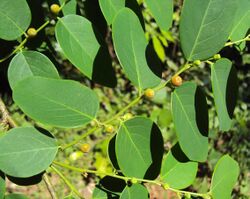Biology:Breynia vitis-idaea
| Breynia vitis-idaea | |
|---|---|

| |
| Scientific classification | |
| Kingdom: | Plantae |
| Clade: | Tracheophytes |
| Clade: | Angiosperms |
| Clade: | Eudicots |
| Clade: | Rosids |
| Order: | Malpighiales |
| Family: | Phyllanthaceae |
| Genus: | Breynia |
| Species: | B. vitis-idaea
|
| Binomial name | |
| Breynia vitis-idaea (Burm.f.) C.E.C.Fisch.
| |
| Synonyms[2] | |
|
List
| |
Breynia vitis-idaea, the officinal breynia, is a perennial tree-like species of Phyllanthaceae (Euphorbiaceae s.l.), found from India east to Taiwan and Okinawa and south to Indonesia. It is a shrub or treelet with egg-shaped leaves that can reach up to 3 m tall. It has staminate flowers and spherical, red fruit.
Breynia vitis-idaea is pollinated by the leafflower moth Epicephala vitisidaea in Fujian, China and the Ryukyu Archipelago, Japan . The moth actively pollinates the flowers, but lays an egg into the space between the external carpel wall and the tepals. The moth caterpillars consume a subset of the tree's seeds, receiving nourishment in return.[3][4]
It contains the saponin breynin and terpenic and phenolic glycosides.[5] It is marketed in Taiwan as Chi R Yun.
Toxicity
Breynia vitis-idaea poisoning causes hepatocellular liver injury.[5]
Other names
Breynia officinalis Hemsley and B. officinalis var. accrescens (Hayata) M.J.Deng & J.C.Wang are synonyms of B. vitis-idaea.
Other variants include:
- Breynia formosana (Hayata) Hayata
- Breynia officinalis Hemsley var. officinalis
- Breynia stipitata Muell. -Arg. var. formosana Hayata
- Breynia stipitata Muell. -Arg. var. formosana Hayata
Other common names in English include:[6]
- Formosan breynia
- Large calyx breynia
- Medicinal breynia
Common names in other languages include:
- Vietnamese: Cù đề
- Template:Lang-nan Script error: The function "transl" does not exist., 紅珠仔 Script error: The function "transl" does not exist., 紅仔珠 Script error: The function "transl" does not exist.
- Chinese: 七日暈; literally: '7-day dizziness'
- Malay: Hujan panas, semomah, seruyan
- Tagalog: Matangulang
- Thai: เพี้ยะฟาน (Script error: The function "transl" does not exist.; [pʰíaʔ faːn]), ดับพิษ (Script error: The function "transl" does not exist.; [dàp pʰít]) (northern), ก้างปลาทะเล (Script error: The function "transl" does not exist.; [kâːŋ plaː tʰáʔ leː]), ผักหวานตัวผู้ (Script error: The function "transl" does not exist.; [pʰàk wǎːn tuːa pʰûː]) (central)[7]
- Japanese: 大島小判の木 / オオシマコバンノキ / おおしまこばんのき (Ōshima kobannoki), 台湾小判の木 / タイワンコバンノキ / たいわんこばんのき (Taiwan kobannoki), 姫小判の木 / ヒメコバンノキ / ひめこばんのき (Hime kobannoki), 高砂小判の木 / タカサゴコバンノキ / こばんのき (Takasago kobannoki)
References
- ↑ Ye, J. (2019). "Breynia vitis-idaea". IUCN Red List of Threatened Species 2019: e.T147650197A147650199. doi:10.2305/IUCN.UK.2019-2.RLTS.T147650197A147650199.en. https://www.iucnredlist.org/species/147650197/147650199. Retrieved 6 November 2022.
- ↑ "The Plant List: A Working List of All Plant Species". http://www.theplantlist.org/tpl1.1/record/kew-24457. Retrieved April 3, 2014.
- ↑ Kawakita, A.; Kato, M. 2004. Obligate pollination mutualism in Breynia (Phyllanthaceae): further documentation of pollination mutualism involving Epicephala moths (Gracillariidae). American Journal of Botany. 91: 1319–1325.
- ↑ Zhang, J., Hu, B., Wang, S. & Li, H. (2012). "Six new species of Epicephala Meyrick, 1880 (Lepidoptera: Gracillariidae) associated with Phyllanthaceae plants." Zootaxa 3275: 43-54.
- ↑ 5.0 5.1 J. K. Aronson. Meyler's Side Effects of Herbal Medicines. Elsevier, 2008. p. 119. ISBN:978-0-444-53269-5
- ↑ Breynia officinalis Hemsley at Plants of Taiwan.
- ↑ ค้นหาข้อมูลพืช (in Thai)
External links
Wikidata ☰ Q154969 entry
 |


